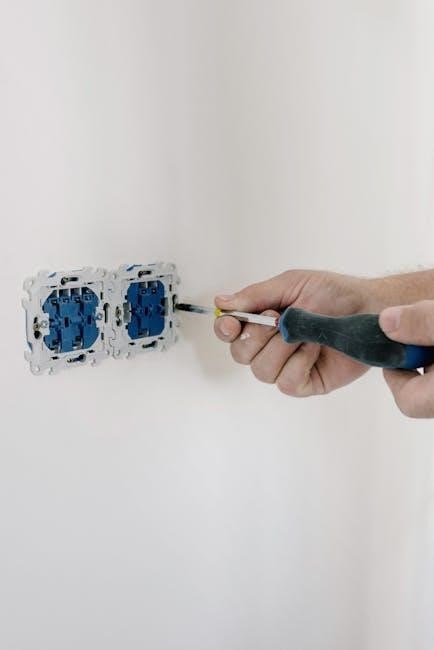Welcome to our guide on Stratocaster wiring! This section introduces you to the fundamentals of understanding and modifying your guitar’s electronics for enhanced tone and functionality.
1.1 Importance of Proper Wiring
Proper wiring is essential for your Stratocaster to function correctly and achieve optimal tone. Incorrect wiring can lead to hum‚ noise‚ or complete loss of sound‚ while correct wiring ensures clear‚ reliable signal flow. It also prevents damage to electronics over time. Proper shielding and grounding are critical for minimizing interference. Accurate soldering techniques and understanding the circuit layout are vital for maintaining the guitar’s performance and versatility. This foundation is crucial for both standard and modified configurations‚ ensuring your Stratocaster sounds its best.
1.2 Key Components of Stratocaster Wiring
The Stratocaster’s wiring system consists of several critical components. These include the pickups‚ which capture string vibrations‚ and the 5-way selector switch‚ which routes the signal. Volume and tone pots adjust the signal’s strength and treble. Capacitors‚ like the 0.047µF‚ refine tone by reducing high frequencies. Shielding and grounding wires minimize hum and interference. The output jack connects the guitar to an amplifier. Understanding these components is essential for proper wiring and achieving desired tones. Each part plays a vital role in the guitar’s overall performance and sound quality.

Standard Stratocaster Wiring Configuration
The standard Stratocaster wiring configuration features a 5-way pickup selector switch‚ three single-coil pickups‚ one master volume‚ and two tone controls. This setup provides a versatile tonal palette‚ allowing players to switch between pickups and adjust brightness and warmth. The wiring includes a 0.047µF capacitor for tone shaping and proper grounding to minimize noise. This classic configuration ensures reliability and iconic Strat tones‚ making it a cornerstone for both beginners and experienced players.
2.1 Components Involved in Standard Wiring
The standard Stratocaster wiring setup includes three single-coil pickups‚ a 5-way pickup selector switch‚ one master volume potentiometer‚ and two tone controls. Additionally‚ a 0.047µF capacitor is used for tone shaping‚ and the wiring harness includes vintage-style push-back cloth wire. The output jack and grounding system ensure proper signal flow and noise reduction. These components work together to deliver the classic Stratocaster tone and functionality‚ providing a reliable foundation for players to achieve their desired sound.
2.2 Step-by-Step Guide to Standard Wiring
Begin by soldering the pickups to the selector switch: neck to position 1‚ middle to position 2‚ and bridge to position 3. Next‚ connect the 5-way switch to the volume potentiometer. Solder the tone pots to the respective pickups‚ ensuring the capacitor is installed between the tone pot and ground. Finally‚ wire the output jack to the volume pot and ensure all grounds are properly connected. Follow this sequence carefully to achieve the classic Stratocaster configuration and tone.

Modified Stratocaster Wiring Options
Explore modified Stratocaster wiring options for enhanced tonal versatility. Discover coil-splitting‚ parallel wiring‚ and blender configurations to unlock unique sounds beyond the standard setup.
3.1 Coil-Splitting and Parallel Wiring
Coil-splitting and parallel wiring offer advanced tonal customization. Coil-splitting uses a push-pull pot to tap individual coils‚ reducing output for single-coil tones. Parallel wiring combines pickups in parallel‚ lowering resistance for a brighter sound. These mods provide versatility‚ enabling players to achieve unique tones while maintaining clarity. Ideal for exploratory players seeking expanded sonic possibilities without sacrificing the Strat’s signature character.
3.2 Blender Wiring for Pickup Blending
Blender wiring modifies your Stratocaster’s electronics to blend pickups in unique ways. This setup uses a potentiometer to mix signals from different pickups‚ allowing seamless transitions between tones. It enables players to create complex‚ layered sounds by combining pickups that aren’t typically paired. Blender wiring offers a wide range of tonal possibilities‚ from subtle warmth to intricate textures‚ making it ideal for adventurous players seeking to expand their sonic palette beyond standard configurations.
Troubleshooting Common Wiring Issues
This section covers diagnosing and resolving frequent wiring problems‚ such as grounding issues‚ pickup malfunctions‚ and intermittent connections‚ ensuring your Stratocaster performs optimally.
4.1 Identifying and Fixing Grounding Problems
Grounding issues are common in Stratocasters and can cause unwanted noise or hum. Start by inspecting all ground wires for breaks or corrosion. Use a multimeter to test continuity between components. Ensure the bridge‚ tremolo system‚ and pickups are properly grounded. Clean oxidized connections and tighten any loose hardware. If issues persist‚ check the jack and output wiring. Proper shielding of the guitar cavity can also reduce noise. Addressing grounding problems is crucial for achieving a clean‚ silent tone and reliable performance.
4.2 Diagnosing Pickup and Switch Malfunctions
Malfunctions in pickups or switches can disrupt your Stratocaster’s sound. Start by testing pickup output using a multimeter to check for short circuits or open coils. Inspect the 5-way switch for worn contacts or corrosion‚ as this can cause intermittent connections. Clean or replace faulty switches. For pickups‚ ensure all wires are securely soldered and free from damage. If a pickup is dead‚ verify its polarity and grounding. Addressing these issues promptly ensures reliable performance and optimal tone from your guitar.

Advanced Stratocaster Wiring Techniques
Explore advanced wiring techniques for your Stratocaster‚ including active electronics‚ custom switching‚ and tone-shaping mods‚ to unlock unique sounds and enhance your guitar’s functionality.
5;1 Custom Switching Options
Custom switching options expand your Stratocaster’s tonal versatility. Install mini-switches for coil-splitting or phase switching to access unique sounds. A blender switch allows blending pickups for intricate tones. These mods enhance versatility‚ enabling players to craft distinctive sounds. Experiment with custom configurations to unlock new sonic possibilities and tailor your guitar to your musical style. Proper wiring ensures seamless integration of these advanced features. Explore and innovate to achieve the perfect tone.
5.2 Active Electronics and Tone Controls
Active electronics elevate your Stratocaster’s sound with enhanced clarity and versatility. Preamps‚ EQ controls‚ and active pickups reduce hum while boosting tonal definition. These systems often include tone-shaping options like bass boosts or mid-scoops. Active circuits provide higher headroom‚ reducing distortion at higher volumes. They also allow for precise tonal adjustments‚ making them ideal for players seeking a modern‚ refined sound. Explore active configurations like EMG or Fishman systems to unlock new dimensions of tone. Experiment with active electronics to discover the perfect balance of power and precision.

Resources for Further Learning
Explore Fender’s official wiring diagrams‚ forums like TDPRI‚ and books for in-depth guides. These resources offer detailed instructions and inspiration for customizing your Stratocaster’s electronics.
6.1 Recommended Wiring Diagrams and Guides
For accurate and reliable wiring‚ refer to Fender’s official wiring diagrams and trusted resources like TDPRI forums. These guides provide detailed schematics for various Stratocaster models‚ including the American Standard Stratocaster wiring diagram. Additionally‚ books like Guitar Electronics: Understanding Wiring and Setup offer comprehensive insights. Websites such as ObsidianWire and Duncan’s Wiring Diagrams are excellent for custom configurations. These resources ensure you can troubleshoot‚ modify‚ or restore your Stratocaster’s electronics with confidence‚ whether you’re a beginner or an experienced player.
6.2 Tools and Materials for Wiring Projects
Essential tools for Stratocaster wiring include a soldering iron‚ wire strippers‚ and a multimeter. Materials like vintage-style push-back wire‚ 0.047µF capacitors‚ and high-quality pots are recommended. A wiring harness or pre-made kit can simplify the process. Ensure you have a well-lit workspace and safety gear. For custom jobs‚ variable resistors or active electronics may be needed. Always use genuine Fender parts or trusted aftermarket components to maintain tone and reliability. Consult diagrams for specific material lists tailored to your project.
Thank you for exploring the Stratocaster wiring guide! With this knowledge‚ you can confidently modify and optimize your guitar’s electronics for the perfect tone and functionality.
7.1 Summary of Key Takeaways
7.2 Encouragement for Experimentation
Don’t be afraid to experiment with your Stratocaster’s wiring! Trying new configurations can unlock unique tones and expand your musical creativity. Whether it’s coil-splitting‚ blender wiring‚ or custom switching‚ every modification is an opportunity to personalize your sound. Remember‚ experimentation is key to discovering what makes your Strat truly special. Take risks‚ stay curious‚ and enjoy the journey of making your guitar an extension of your musical vision. Happy wiring!

